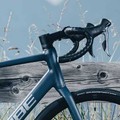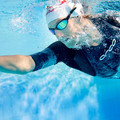
Precision Fuel & Hydration’s
Triathlon Nutrition Guide
With the help of Lexi Kelson, dietician at Precision Fuel and Hydration we've put together a triathlon nutrition guide so you can formulate a triathlon nutrition plan that matches your requirements.
The nutrition part of the plan…
As a triathlete, you know how to work hard in training and out on the race course. But to do that, you need to fuel and hydrate well, providing your body with the necessary nutrition to optimise and sustain performance. Just like with other sports, it comes down to ‘The Big 3’ key levers… carb, sodium, fluid.
Let’s start with carbohydrates: this macronutrient is the main source of energy for your efforts. Compared to the other two macronutrients (protein and fat), it’s going to be easier to digest and absorb, making it a quicker source of fuel to propel you forward. So, while we’ll touch on the time and place for protein and fat a bit further down, your main goal should be getting enough carbohydrates in.
The amount of carb you need depends on the duration and intensity of exercise, as you can see in this visual guide.
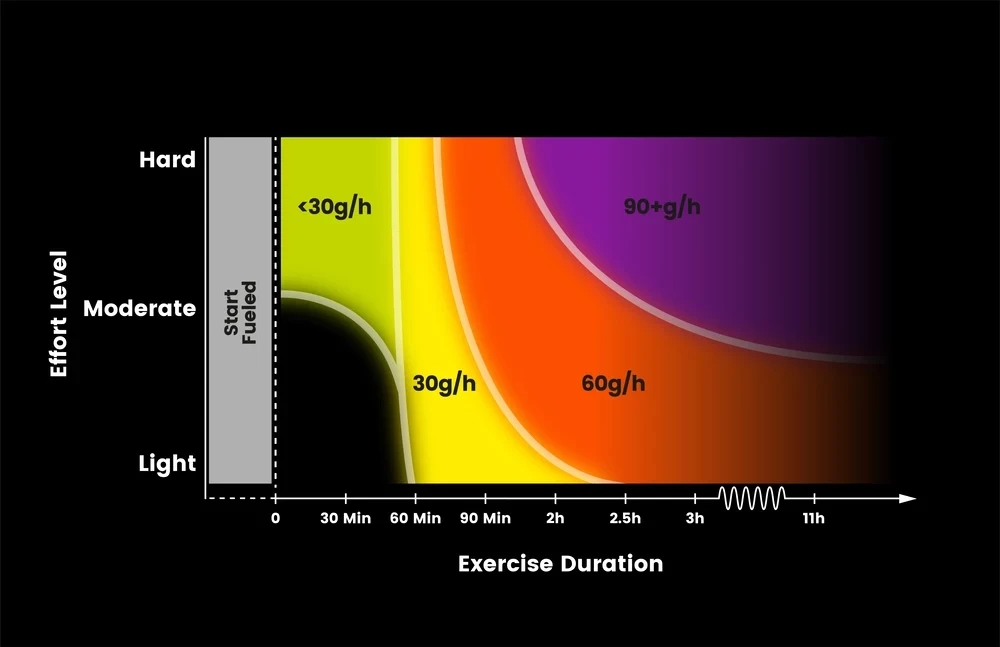
The caveat is going to be how much you’ve trained your gut to tolerate, as GI distress is not going to solve your low energy availability problems! Instead, take a strategic approach to gut training and incrementally increase the carbohydrates you take in during training in order to be comfortable at your target amount on race day. You can dive more into the science and application of gut training here.
In addition to getting used to the amount of carb you need, it’s also important to practice with the specific types, formats, products – nothing new on race day is a cliche that has stuck around for good reason.
What triathlon nutrition products to use?
While the format of carb is lower on your priority pyramid, you do want to focus on simple carbohydrates for their easily digestible format, and this often is found in sports nutrition products like gels.
PF&H Gels have a 2:1 glucose to fructose ratio which the science suggests is an effective way to maximise the amount of carb you can take up, since glucose and fructose are absorbed through different transporters.
Within the PF&H range, you can choose from different sizes of gels, a Flow Gel (thinner consistency, easier to carry more carb) or a gel with caffeine (100mg). All of these bode well for triathlons, as they’re easy to carry, open and take while on the move.
Since we know flavour fatigue can be a real issue, especially for those full-distance triathlons, it can be helpful to vary the taste and texture of your fuel. The tricky part is still balancing this with the priority of simple, easily digestible carbohydrates, as often energy bars, snack foods, and other ‘real foods’ come with fat, protein, fibre and a higher risk of GI distress.
PF 30 Chews and the PF 60 Chew Bar are a great compromise. They come in the ‘original’ mild, neutral flavour, or a mint & lemon flavour, both of which deliver a change in taste and texture without sacrificing your simple carb targets.
If you are doing a full distance triathlon and operating at an overall lower intensity, you may find it viable to have additional ‘real food’ options on the bike. We tend to see more GI distress on the run so maximising fueling while on the bike can be a good strategy. If you do venture into more ‘real food’ territory, try to prioritise carbohydrate sources, such as dried and fresh fruit, pretzels, rice balls, etc.
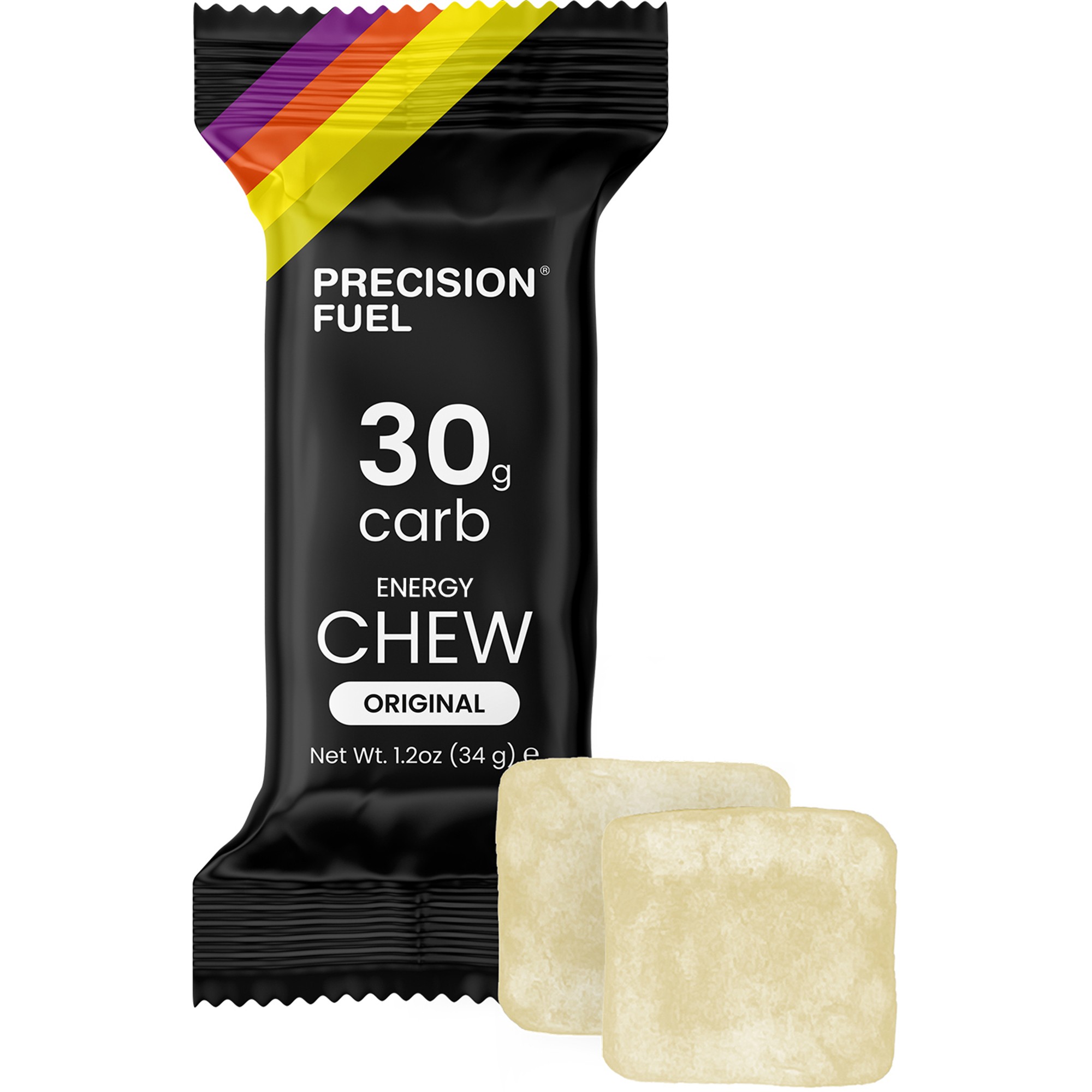

What about outside of the actual race fueling?
Day-to-day nutrition shouldn’t be forgotten, as it’s going to play a significant role in your ability to train and recover well, which ultimately fuels your performance on race day.
One of the biggest challenges for endurance athletes is to make sure they’re eating enough overall energy to support the long training days. While some individuals do well with tracking their intake and diving into every detail, often a more practical and visual approach can be a starting point as well as a sustainable method long-term. (It goes without saying, but always reach out to a sports dietitian for an in-depth look at your dietary intake and to help develop a strategy that works for you.)
Carbohydrates are just as important outside of training and race as they are in, so don’t skimp on nutrient-dense sources of carb on a daily basis. The general recommendation for athletes is 5-8 grams of carb per kilogram of body weight per day.
- Protein is important for muscle repair, so put your protein priorities into place:
- Total daily protein is the most important: ~1.6 to ~2.5 g per kg (higher end 2.2-2.5 for extra demanding seasons)
- Break down your total number into 3-5 servings
- Distribute those servings evenly(ish) throughout the day, such as every 3-4 hours
- Know your serving sizes. Weigh it out for a few times so you can see what an appropriate amount of your go-to protein sources looks like to hit your target
Fat is the most energy-dense macronutrient, so if you’re someone who struggles to eat enough day-to-day to bolster your performance, rely on more fat sources in your meals to amp up your energy intake and support recovery. Several vitamins are also fat-soluble so to make sure you’re optimising your overall health from a general wellbeing as well as a performance standpoint, you need enough fat in your diet.
As mentioned above, sometimes a visual approach to fueling day-to-day can be the way to go. Performance plates are a great way to accomplish this.
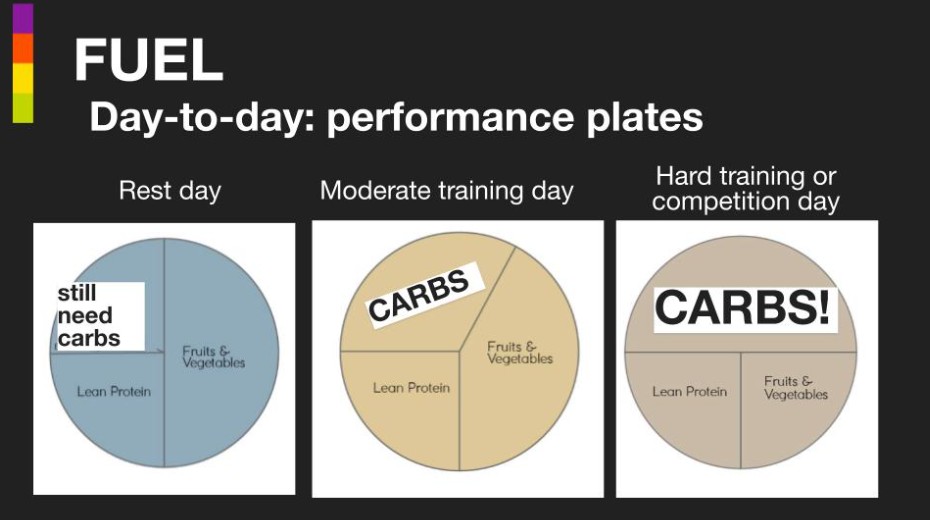
Triathlon Nutrition For the Days Surrounding a Race
Carb loading is another one of those cliches that is cliche for a reason – it works. Don’t forget to maximise your muscle and liver glycogen stores in the 2-3 days pre-race by increasing the proportion of carbohydrates in your diet. To reduce the risk of GI distress and feeling overly full, pull back on fibre and fat to make room for more carbohydrates. Load up on things like white starches, fruit juices, condiments (honey, jam, syrup) and even Carb Drink Mixes to accomplish your carb load without bloating. Throw in a handful of sweets too for good energy-dense measure! And, just because you’re tapering leading into a race doesn’t mean you need to eat less… you still need to eat more carbs to maximise your storage capacity.
Breakfast on race day should also be carb-rich, easily digestible and consist of approximately 1-4 grams of carb per kilogram of body weight. Check out the Case Study database for examples of what some of our PF&H athletes eat religiously before toeing the line.
Just like practicing your in-race nutrition is paramount, you should also practice what you’re going to eat pre-race. Especially as a triathlete, you’re often traveling to far places for a race, so factor in what foods you’ll have available and plan + practice accordingly.
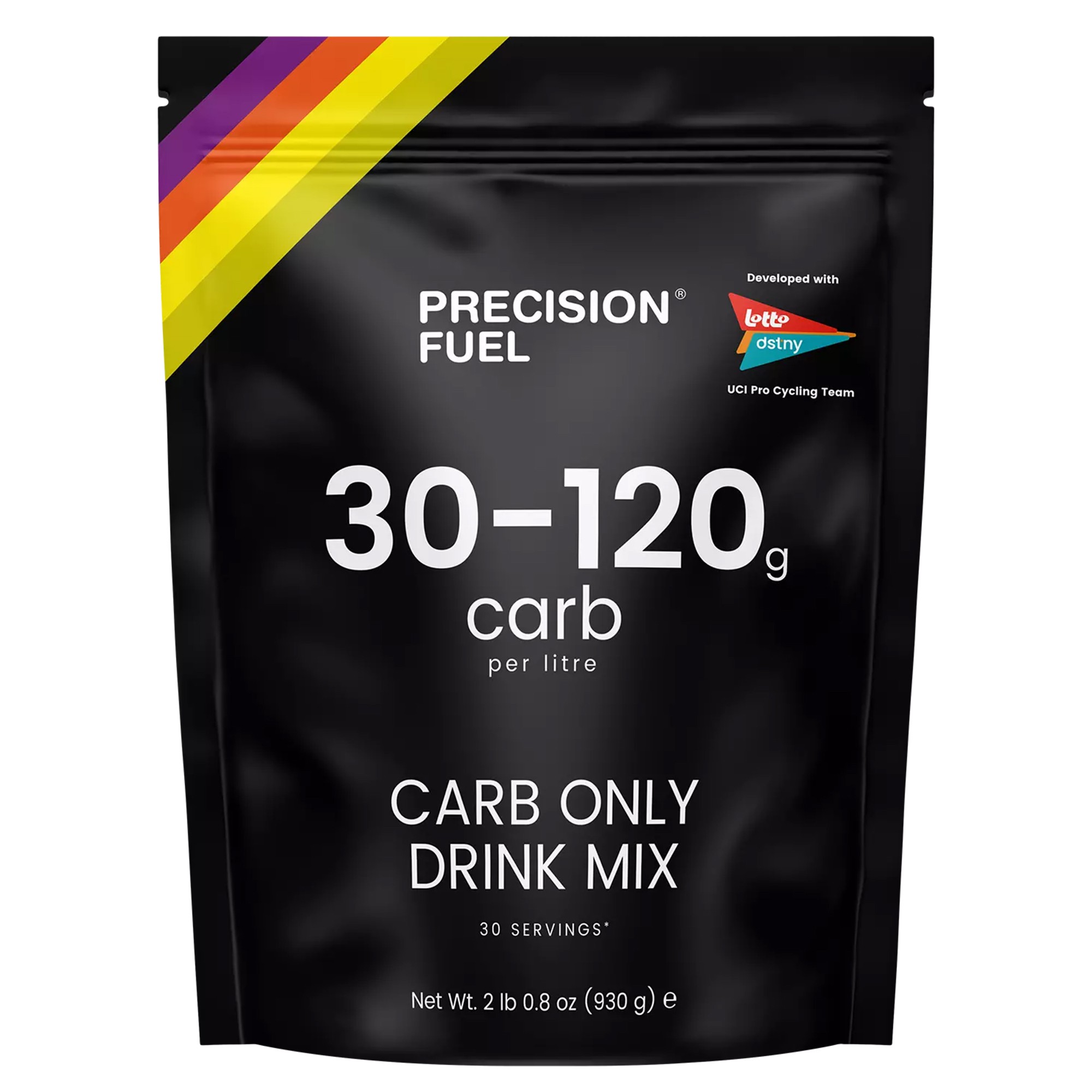

Triathlon Hydration
Circling back to the very beginning, we still have two of the three key levers to cover. Sodium and fluid are two sides of the same coin – hydration. You need both to perform your best in a triathlon!
To figure out how much of these two you need, the best thing you can do is undergo a test for each. A sweat sodium test can tell you exactly how much sodium you need relative to the amount of fluid. It measures your sweat sodium concentration which is largely genetically determined and can range from 200mg per litre to 2,000mg per litre. Check out our map of Sweat Test Centres to find the closest location to you or consider looking into something like the Flowbio.
Sweat rate testing is the way to figure out how much of your optimal electrolyte drink you need to consume to compensate for your total sweat losses. This is a measurement best done by weighing yourself before and after a training session – follow the steps and use the downloadable spreadsheet in this blog. Tailor these measurements to the weather conditions of the race you’re preparing for, as you will be sweating more or less in hotter or colder weather. While sweat rate varies based on weather conditions and intensity, sweat sodium concentration will stay fairly stable. So, once you know what strength of drink you need, you can dial up or down the total amount of that drink that you consume.
The PF&H multi-strength electrolytes come in 250, 500, 1000, and 1500 strengths to match your relative sodium concentration as determined by your Sweat Test results. You can drop a tablet or packet of the appropriate strength in your bottles and drink accordingly. On the run, many athletes prefer to switch to Electrolyte Capsules if they don’t plan to carry a bottle for this portion of the race (especially our middle or shorter distance triathletes).
Since the key for your hydration strategy is to focus on relative sodium concentration, make sure you’re taking in the right amount of sodium relative to the amount of fluid you’re taking in. For example, if you need 1,000mg of sodium per litre, but you’re carrying 500ml bottles, you would need 500mg of sodium in each bottle. That’s 1 tablet or packet of PH 1000. However, if you have a litre bottle on your bike frame, you’d need 1,000mg of sodium, which would be 2 tablets or packets of PH 1000. For the Capsules, each is 250mg of sodium – pairing this with aid station cups of plain water (which are typically around ~60-80ml), you’d want to take 1 capsule for every ~3-4 cups.
Hydration around the days of the race
Preloading before a race is a way to make sure you are starting optimally hydrated. Regardless of your sweat sodium concentration, the preloading protocol uses a higher strength electrolyte to boost blood plasma volume, encourage water retention and increase circulating electrolytes. Take 1 x PH 1500 in 500ml the night before and the morning of a race (finishing this about 45-60 minutes before the start). And you don’t want to chug a lot of extra plain water in this time frame as this would dilute down the electrolytes you just took in!
Should you put carbs in your bottles?
The answer is one I should have tattooed on my forehead at this point as a dietitian… ‘it depends’. The longer and hotter the race, the more beneficial it can be to ‘decouple’ your fuel and hydration. This means taking in your carbs separately from your fluid and sodium in order to be able to drink enough of your electrolyte drink to match your sweat losses in the heat without overloading your gut with carbs.
Hotter temperatures will cause your body to direct blood flow away from the gut and towards the skin to cool your body down, ultimately reducing your stomach’s ability to comfortably digest and absorb the fuel you're taking in. While gut training can certainly help this, it can still be helpful to separate your carb from your fluid + sodium as a way to ease the stress on your gut.
As a full-distance triathlete, you might span several temperatures over the course of your race. In this case, you can opt for a more decoupled strategy later in the race, specifically during the run, when the biomechanics of running will compound with the heat and make GI distress more of a risk.
If you’re doing a middle or shorter distance, and/or the weather is mild or even cold, combining your carb, sodium and fluid into one bottle becomes a much more viable option. Carb & Electrolyte Drink Mix, or Carb Only Drink Mix with your appropriate PH tablet strength, is a practical way to hit your numbers.
Check out this blog on the differences we see in middle vs. full distance triathlon strategies, and then head to our database of triathlon Case Studies for real life scenarios with our PF&H athletes.



